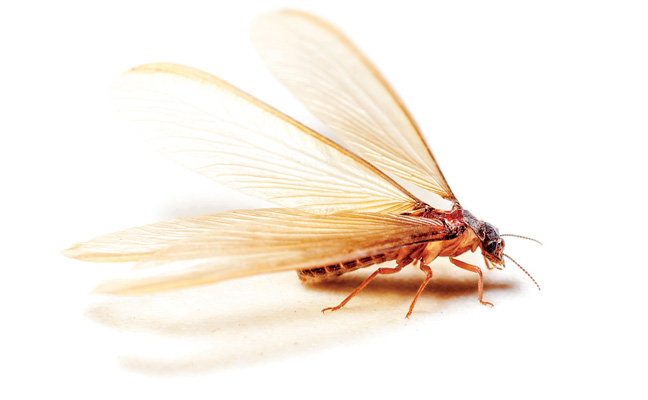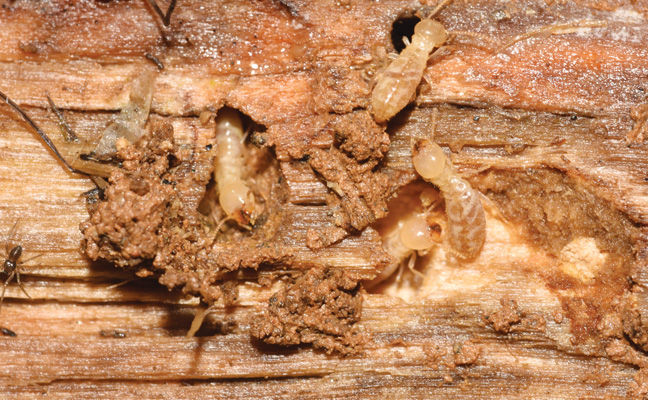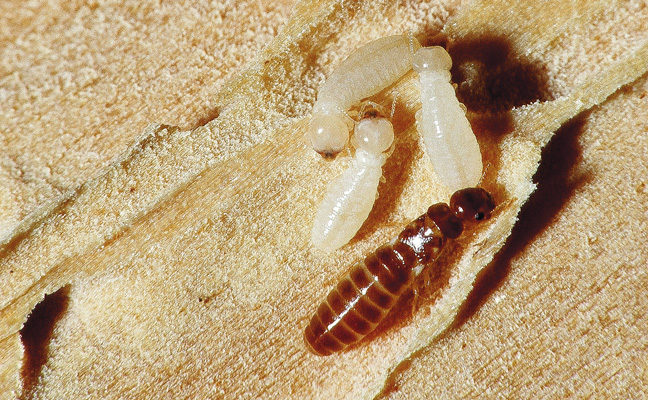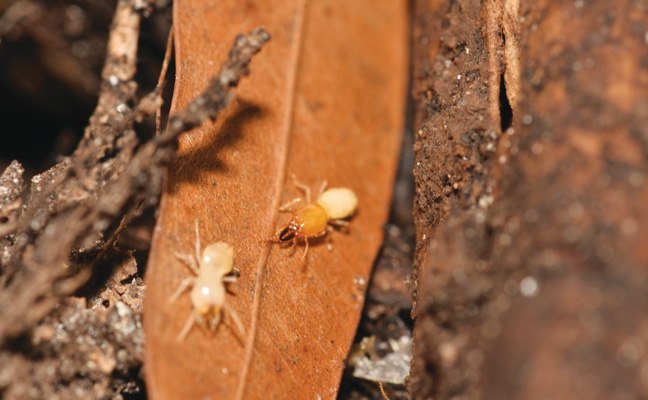
PHOTO: DENBOMA/ISTOCK / GETTY IMAGES PLUS/GETTY IMAGES
Can you look at termite damage and tell how old it is? It’s a trick question. No one can.
That’s one of the points Dr. Faith Oi, a University of Florida (UF) associate extension scientist and Pest Management Professional (PMP) editorial advisory board member, underscored during her presentation at the National Pest Management Association’s (NPMA’s) PestWorld 2019 conference in San Diego, Calif.
During her presentation, Dr. Oi — director of UF’s Pest Management University, as well as Florida’s integrated pest management (IPM) program for schools — focused on litigation and claims in termites and other wood-destroying organism (WDO) work.
She noted that much of today’s litigation in the industry continues to revolve around termites. It’s something we can only fight with education and training — not only of attorneys and clients, but our technicians, too.
“It’s just not possible to accurately date termite damage, because of the many variables,” Dr. Oi said, offering the species and number of feeding termites, availability of other food sources, the weather, and the humidity range as just a few examples.
Much of the termite feeding depends on the type of wood, but not just the species of wood. The part of the tree used in construction matters, as well.
“Are you using sapwood or heartwood? This affects consumption,” she added. “Even groups of termites within the same colony have variable consumption rates.”
THE THOUGHT EXPERIMENT

Subterranean termite (Rhinotermitidae). PHOTO: NPMA
If we can’t accurately quantify it, then why do we see wood consumption estimates in training materials, including the NPMA research report on termites? Dr. Oi referred to these estimates as useful in “thought experiments” in academic exercises. For example, the number of termites needed to consume 1 gram of wood at 75°F is listed as 18.315, and is primarily based on laboratory studies of colonies with known characteristics.
In real life, Dr. Oi said, it is almost impossible to know how many termites are in a colony or feeding at a site.
“Our methods on colony estimation have evolved from taking backhoes and shovels of termite-infested soil to mark-release-recapture, but through these experiments, we learned that we may be violating the model assumptions,” she said in a follow-up interview with PMP.
“A statistician once said, ‘All models are wrong, but some are useful,’” she quipped.
SCIENCE MISUSED
Dr. Oi warned that some arguments in lawsuits misuse science. As an example, she described one laboratory study that measured the moisture moved by subterranean termites from one area to another. Based on this finding, it has been incorrectly argued that the failure to control termites caused the conducive condition, as opposed to the more reasonable argument that the moisture created a conducive condition for the termites.
The study was conducted in a Petri dish setup containing 20 termites and with several replications. “Scientifically, there is nothing wrong with this setup,” Dr. Oi told PMP. “However, how the results are allegedly being used is a misuse of science.

Drywood termites (Kalotermitidae).PHOTO: COURTESY OF, AND COPYRIGHTED BY, GENE WHITE, PMIMAGES@EARTHLINK.NET
“Here’s why,” she continued. “The experiments are set up in a controlled, closed system, designed to minimize the evaporation of water because the objective of the experiment is to measure the movement of water. Compare this purpose with the design of wall assemblies in homes of the Southeast. They are designed to rid the home of excess moisture. Thus, extrapolating the laboratory study’s findings to a real-world house is like comparing apples to oranges. It is not a valid comparison.”
At PestWorld, Dr. Oi told attendees, “The salivary reservoir size of a single termite has been measured at 0.7 microliters. There are about 50 microliters in a drop of water. Hypothetically, if you have 1 million termites, multiplied by 0.7 microliters, you have a maximum of about 2.9 cups worth of water that termites might be moving around. Building sciences research suggests that average activity in the home produces about 3 gallons of water a day, just through normal activity.”
In other words, to pin the moisture content solely on termites is like blaming a few drops of ink in a mud puddle.
“The argument that termites cause conducive conditions ignores a large body of data that termite mortality is higher in drier environments, and there is increased survival and consumption if conducive conditions already exist,” she told PMP, noting this negates the argument that a termite control failure can allow enough termites into a structure and cause conducive conditions. However, she added, “conducive conditions can lead to termites.”
“Termites are blind, soft-bodied insects that have to have moisture to survive,” she said. “Consumption does increase with moisture, which is predictable, but it also varies by colony, which is not predictable. This reinforces why you cannot date damage from termites.”
WHAT PMPS CAN DO
Dr. Oi stressed that technicians must conduct an inspection based on the biology of the specific termite species. The type of soil they are working with can influence the length of efficacy of various products, so train technicians to not only follow, but understand the label and why it is worded the way it is.
“My mantra for 2020 is implementation,” she said. “We can talk about training and education all day, but we need implementation of what we’ve learned.”
In her post as director of Pest Management University, Dr. Oi said, she and her team have identified several spots that termite technicians could revisit and improve upon, including:
- Correct identification. Treating for subterranean termites will be different than treating for drywood termites. There also may be confusion with swarming ants and termites to the untrained eye. If you need help with ID, contact your local county Extension office. They will be able to point you in the right direction.
- Do the math correctly when mixing and applying termiticide. The NPMA has a comprehensive worksheet you can download here, to help ensure accuracy.
- Don’t be afraid to get dirty. “If you don’t want to get dirty, you shouldn’t be a technician in this industry,” she told PMP.
- Document, document, document. Dr. Oi told attendees that keeping photos, notes and video of specific accounts, even in perpetuity, is a cost-effective way to ward off lawsuits. “Check with your attorneys,” she advised, “but overall it should be legible, signed and dated.” Also, it is as important to document what you could not inspect.
- Inform the client of your findings and of any conducive conditions. Despiteher obvious talent for public speaking, Dr. Oi admitted to attendees she’d rather be in the lab than talk to a room full of people. But she stressed the need to practice presenting your message to customers: “Communication is a different skill set than doing pest control, but it’s just as important.”

Formosan (Coptotermes formosanus, pictured) and Asian (C. gestroi) subterranean termites. PHOTO: NPMA
KNOW YOUR TERMITES
There are approximately 3,000 termite species worldwide, 45 of which are in the United States. Commonly encountered termites include:
- Subterranean termite (Rhinotermitidae) infestations are best avoided by using good building construction practices. Eliminate wood-to-ground contact; divert water away with proper grading and functioning downspouts, gutters and splash blocks; and maintain clear inspection spaces.
- Drywood termites (Kalotermitidae) typically can be avoided by regularly inspecting the property for signs of drywood termites, such as fecal pellets that are uniform and six-sided. Pay special attention to window and doorframes, trim, eaves, siding, attics and wooden furniture. Drywoods eat against the grain of the wood, leaving smooth galleries because they are not connected to soil.
- Formosan (Coptotermes formosanus, pictured) and Asian (C. gestroi) subterranean termites are invasive species. Control methods are the same as our “native” subterranean termites. Regular and thorough inspections by trained professionals are key to any termite management program.
The post Put training in your termite toolbox appeared first on Pest Management Professional.
from Pest Management Professional https://www.mypmp.net/2020/02/04/put-training-in-your-termite-toolbox/
Sacramento CA
No comments:
Post a Comment